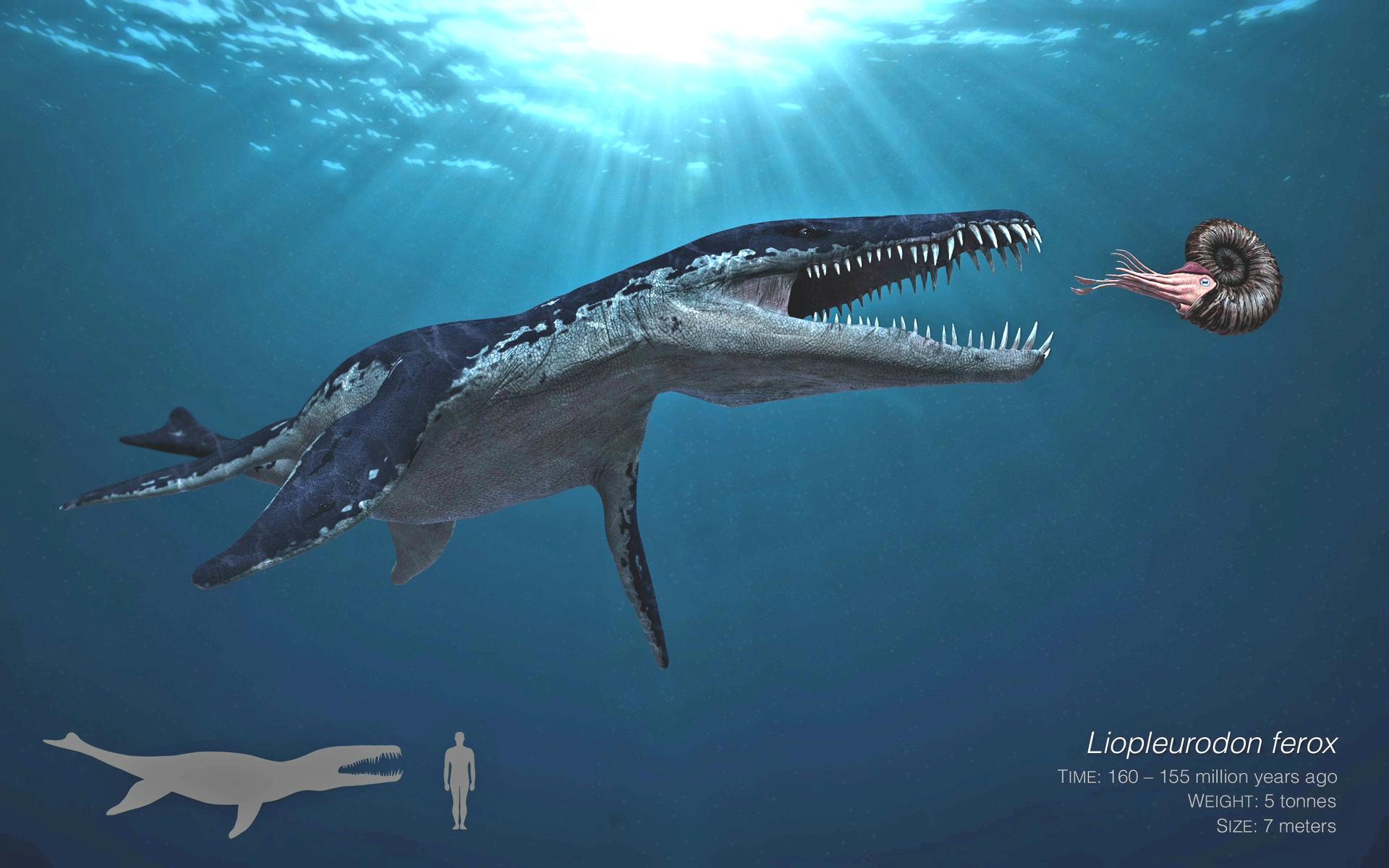Facts
Liopleurodons in the group of marine reptiles, were quite fierce. That is, to fish, squid and sometimes even marine reptiles! These prey reptilians were usually like icthyosaurs and
stenopterygius. Liopleurodon, the marine reptile that we are are working on, had many capabilities. Although there was one annoying thing. That was that , unlike modern day
lions and wolves, the teeth could not tear apart the catch. No need to fret! Big and strong
bones came out of the spinal cord top anchored powerful neck muscles. The Liopleurodon would use this capability to the jaws from side to side to tear the victim apart.
Then the Lioperiodon has a feast by he/herself. The skin of a Liopleurodon was kind of like those of a shark's. After all,
Icthyosaurs were VERY fast. The longest Liopleurodons ever discovered was 49 ft long. the skull for that would be 5 ft long! That is as long as an adult is tall.
They lived at about 165-161 million years ago. The scientific term is Liopleurodon ferox.
Actions
These creatures used their flippers slightly differently than you might think. They 'fly' through the water almost like a bird, or a rowboat. This could have helped
the Liopleurodon propel and accelerate because you give all of the force backward no at a down angle. The flippers kind of go in a circle. Did you know that the
technique of pliosaurs was tested by a swimming model robot that was most likely what a Liopleurodon act like?
The power of the Liopleurodon was enough to burst out of the ocean and possibly nab a pterodactyl or something. The Liopleurodon a great sense of smell and
could smell blood from a mile away.
What they actually look like
Plesiosaurans possess an unusual body plan with a stiff trunk, a short tail and smooth teeth. They had leaf shaped flippers and the current understanding of
their anatomy of the nervous system. They look like Tylosaurus, except for all the armor. As you can see, the flippers were about as large as the legs of a person.
Something kind of weird about this image is the tip of the tail.The Liopleurodon, had quite large nostrils, for the size of the head.
So did ichthyosaurs. The teeth of Liopleurodon were big, strong and pointy. The back, was ocean blue, the belly white, like the ocean foam. This creature may
not have needed all this camouflage, being top predator and all. But still, a pink Liopleurodon would look weird.
Scientist think it may have helped to creep up on the prey.

Fossil sites
A tooth was located near Boulogne-sur-Mer, obviously, in France. There are more sited in England and 1 in Russia. As you can see, we are literally guessing the whole body.
There are also VERY small sites in Germany. based on modern technology, we can guess A LOT. Another liopleurodon was discovered in Kazakhstan, in the settlement of
Shchuchino. All of these pieces are located in the Laboratory of Paleozoology in Kazakhstan.
Pliosaurus macromerus was partly found in Bazhanov, Russia.
Skeletal structure
According to Dmitry V. Malkanhov, The front of the body surface of the back vertebrae bears double-stripped rugosity(how wrinkled something is. (: ). Caudal vertebrae
with chevron bone facets. The lateral surface of the centrum bears rib facets, which are born on pedicles. The superior rib facet is triangular in outline, the inferior one
is almost round. The size of both facets is almost equal. The edge of the facet is slightly convaced, it bears a number
of irregularly shaped holes/pits. The centrum is round in outline, with well developed peripheral groove. There is a finely developed boss \, or mammilla in the center
of each articulating surface. The boss is punctured by the nutritive foremen. The lateral surface of the centrum between
superior rib facet and neural arch is smooth with no indication of ridge. The ventral surface is sculptured with clearly distinguished rugosity. There is no evidence
of both the front of the body keel and ventral(front of body)lip presence. After all, they are basically reptiles.
Do lizards have them? The cervical vertebra is short, length less than half of width or height.
Measurements of the cervical vertebra No. 7/13-1958, mm, length –– 49 width –– 124, height –– 118.
Dorsal vertebrae No. 19/13–1958
The centrum is rather pear-shaped, narrowing upward. The articulating surfaces bear well developed boss in the center, which is punctured by pit. The ventral
surface has well marked double-stripped rugosity near the border between the ventral surface these strips of rugosity is remarkably smoother
Measurements of the dorsal vertebrae No. 19/13 – 1958, mm: length –– 79,width –– 138, height –– 145.
Caudal vertebra No. 3/13–1958
The centrum bears one elongated dorso-ventrally rib facet on each lateral surface. Rib facets are born on pedicles. The centrum is almost round in shape. Small
mammillae with nutritive foremen are situated in the center of each articulating surface. Articulating surfaces are slightly concaved. The outline of the centrum is
sharp, without suggestion of the peripheral groove. The well developed ridge occurs on the lateral surface of the centrum
is sculptured between rib facet and neural arch. The ventral surface of the centrum is sculptured and bears a pair of nutritive foramina. The well developed
chevron bone facets are found on the ventral surface of the centrum. The centrum is slightly extended downward in crossection.
The caudal vertebrae is short, its length measured in the midline is less than half of width or height.
Measurements of the caudal vertebra No. 3/13–1958, mm: length –– 43, width –– 115 .
Quick note: Sorry if this is very complicated text
References:
https://dinopedia.fandom.com/wiki/Liopleurodon
https://www.researchgate.net/publication/285685402_Comparative_cranial_anatomy_of_two_North_American_Cretaceous_plesiosaurs
Malakhov, Dmitry; Giant Pliosaur (reptilia; Sauropterygia) From The Late Jurassic Of Kazakhstan And Some Remarks On The Systematics Of Pliosauridae, 1999
Dinosaur!, Dinosaurs and other amazing prehistoric creature as you've never seen them before, copyright 2014